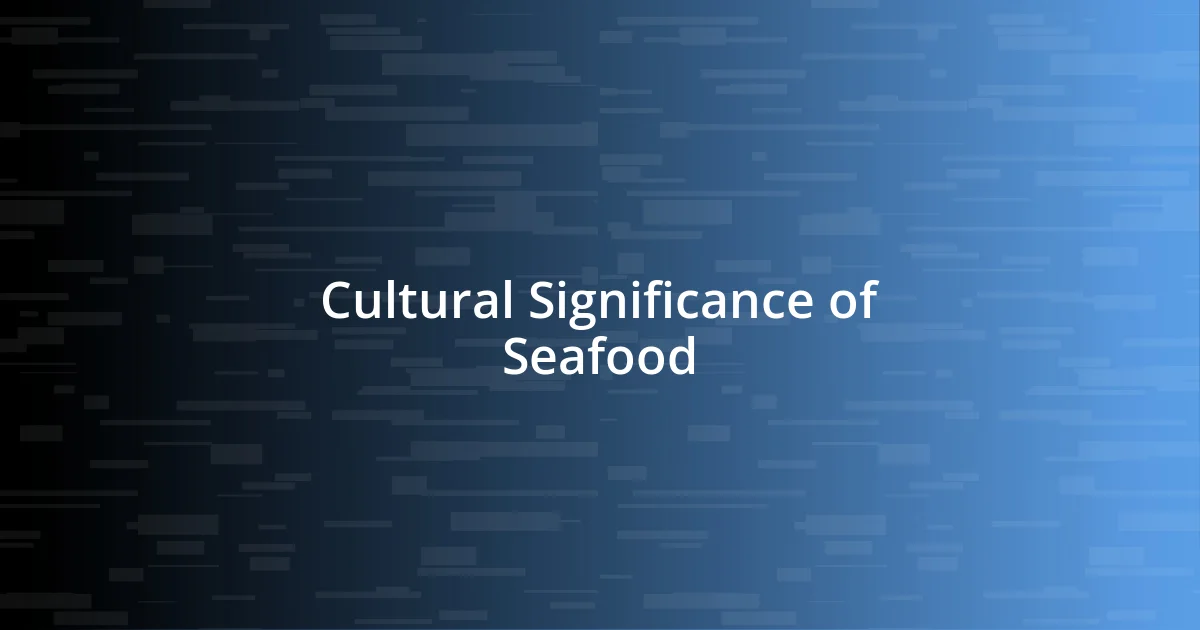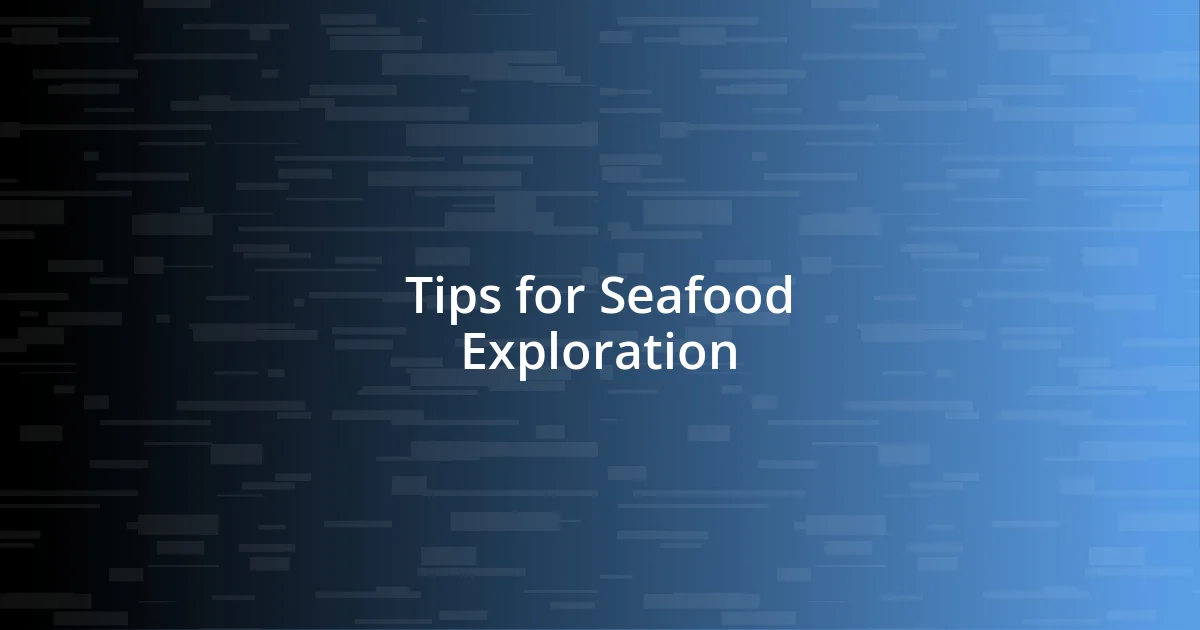Key takeaways:
- Seafood embodies cultural significance and local traditions, connecting communities to their heritage and environment.
- Sustainable seafood practices are vital for preserving marine ecosystems and understanding responsible consumption through certification labels.
- Exploring seafood involves embracing freshness, regional specialties, and diverse cooking techniques that enhance flavors and culinary experiences.

Introduction to Global Seafood
Seafood is a remarkable tapestry of flavors, cultures, and traditions found in kitchens around the world. I remember my first taste of fresh sashimi in Tokyo; the delicate texture and rich umami flavors left me in awe. This experience ignited my passion for exploring the diverse seafood offerings that different cultures have to offer.
As I traveled to coastal cities and remote fishing villages, I discovered that seafood is not just a dish but a way of life. Have you ever paused to think about how a simple plate of shrimp or fish can tell a story? Each bite connects us to the ocean and the communities that depend on it, highlighting the delicate balance between nourishment and sustainability.
From spicy crab curries in India to the nuanced dishes of Mediterranean cuisine, the variety of seafood showcases the ingenuity of chefs and home cooks alike. I often find myself reflecting on how every region has its signature seafood dishes, shaped by local traditions, availability, and environmental factors. Isn’t it fascinating how our tastes can evolve through these global culinary journeys?

Types of Seafood Varieties
Exploring seafood varieties has been an eye-opening journey for me. Each type carries with it a unique story and a special connection to the region from which it hails. I still recall the first time I sat on a sun-soaked pier in Barcelona, indulging in a plate of fresh calamari, cooked to perfection. The crunchy exterior paired with tender fish was an unforgettable delight!
When it comes to seafood, the varieties are astonishingly diverse. Here’s a snapshot of just a few popular types:
- Fish: Includes varieties like salmon, tuna, and cod, boasting different flavors and textures.
- Shellfish: Encompasses shrimp, crab, and lobster, adding a sweet and rich profile to various dishes.
- Mollusks: Think clams, oysters, and mussels; each offering a briny burst reminiscent of the ocean.
- Cephalopods: Such as octopus and squid, known for their unique textures and often used in Mediterranean and Asian cuisines.
- Sea Vegetables: Like seaweed and kelp, often featured in salads and soups, enhancing both flavor and nutritional value.
Every time I try a new seafood dish, I feel a thrill of adventure. It’s like tasting a piece of the ocean’s narrative — a reminder of how interconnected we all are through the bounty of the sea.

Sustainable Seafood Practices
Sustainable seafood practices are becoming increasingly essential as we navigate the challenges of overfishing and environmental impact. In my experience wandering coastal towns, I’ve encountered fisheries that prioritize sustainability, often using methods like tidal and selective fishing which not only protect juvenile fish but also help maintain the ecosystem. I remember a particularly enlightening conversation with a local fisherman in Maine who passionately described how he practices catch-and-release, ensuring he only takes what the ocean can sustainably provide.
When I first tried shopping for sustainable seafood, I was truly taken aback by the range of certification labels available. Understanding which ones to look for can feel overwhelming, but it’s incredibly rewarding. The Marine Stewardship Council (MSC) and the Aquaculture Stewardship Council (ASC) are two leading organizations that certify sustainable seafood practices. They act as a guide for consumers like us who want to enjoy seafood without contributing to depletion or damaging habitats. Once I started paying attention to these labels, it transformed how I viewed my seafood choices, making me feel more connected to the ocean’s health.
Engaging in sustainable practices not only supports our oceans but also fosters a sense of responsibility toward future generations. Recently, when I visited a community-supported fishery, I witnessed how connecting directly with local fishermen leads to more transparency in our food choices. It was so heartwarming to see families purchasing seafood while having meaningful conversations about fishing methods and seasonal catches. It felt like we were all contributing to a movement that honors both the sea and the beautiful people who rely on it.
| Practice | Description |
|---|---|
| Catch-and-Release | Taking only as needed while ensuring fish populations can replenish. |
| Selective Fishing | Methods that target specific species, reducing bycatch and protecting juvenile fish. |
| Community-Supported Fisheries | Direct purchase of fresh, local seafood, creating a bond between consumers and fishermen. |
| Certification Labels (MSC, ASC) | Indicators of sustainably sourced seafood, ensuring it meets environmental standards. |

Popular Seafood Dishes Worldwide
Some of the most cherished seafood dishes worldwide shine a spotlight on freshness and local flavors. Take paella from Spain, for instance—this vibrant saffron-infused rice dish brings together a medley of seafood like shrimp, mussels, and calamari. I remember the first time I tasted it at a lively seaside market in Valencia; the burst of flavors and the beautiful presentation felt like a feast for both the eyes and the palate. Can you imagine finding a dish that embodies the very essence of its landscape? That’s what paella did for me.
Then there’s sushi—a Japanese delicacy that has captivated palates around the globe. Whether it’s a beautifully crafted nigiri or a colorful maki roll, each piece showcases the mastery of fresh fish. My love affair with sushi began on a trip to Tokyo, where I was lucky enough to enjoy an omakase experience. With each bite, I felt as if I was indulging in art, each ingredient carefully selected for harmony. It really got me thinking—what’s better than taking part in a centuries-old tradition that celebrates the ocean’s gifts?
In the southern United States, shrimp and grits hold a special place in culinary hearts and homes. The dish, with its creamy texture and savory shrimp, tells a story of comfort and warmth. I still fondly recall sharing a plate of this with locals in Charleston, who taught me how to perfectly season the shrimp. It sparked a delightful conversation about heritage and family recipes. Isn’t it fascinating how food can create connections across cultures and generations? Each of these dishes reflects not just regional flavors but also the essence of community and connection that seafood inspires worldwide.

Seafood Preparation Techniques
When it comes to preparing seafood, I’ve found that techniques can vary widely depending on culture and the type of seafood being used. For instance, grilling fish is a favorite in many coastal regions, as it brings out that smoky flavor while allowing the fish to remain flaky and tender. I remember attending a summer cookout where the host marinated salmon in a citrus blend before grilling it; the result was a perfect harmony of zesty and earthy notes. Isn’t it amazing how a simple method can elevate the natural flavors?
Another technique that has caught my attention is poaching. This gentle cooking method keeps the seafood succulent, especially when using broth infused with herbs and spices. I once experimented with poaching scallops in a white wine reduction and was pleasantly surprised by how the subtle flavors melded beautifully. It got me thinking, how often do we overlook the elegance of simplicity in our cooking methods?
Then there’s the art of ceviche, which truly fascinated me during my travels in Peru. The process involves marinating raw fish in citrus juice, essentially “cooking” it without heat. I still recall my first taste—fresh pieces of fish delicately mixed with onions, cilantro, and a kick of lime—each bite felt like a burst of ocean and sunshine. Ceviche has taught me that preparation doesn’t always demand heat; sometimes, it’s the ingredients that do all the talking, creating a refreshing dialogue with our taste buds.

Cultural Significance of Seafood
The cultural significance of seafood runs deep. In many coastal communities, fish and shellfish aren’t just staples—they’re integral to identity. I recall visiting a fishing village in the Mediterranean, where fishermen proudly shared tales of their daily catches, revealing how the ocean shapes their traditions. This connection to the sea fosters a sense of belonging and continuity that resonates through generations. Have you ever wondered how food can anchor us to our roots?
In Japan, for instance, seafood transcends mere sustenance; it’s a revered art form. I vividly remember visiting a sushi restaurant where the chef took immense pride in showcasing his craftsmanship. Each slice of fish and every grain of rice had meaning, reflecting respect for nature and the artistry of preparation. This experience made me realize that seafood dishes can encapsulate an entire culture’s philosophy toward life, nature, and community. How powerful is that—a meal embodying a shared worldview?
The rituals surrounding seafood also highlight its importance across various cultures. Whether it’s the intricate dance of preparing lobsters in New England or the festive feasts of seafood paella in Spain, these practices bring people together. I had the pleasure of joining a family gathering in the Caribbean where the highlight was a lush feast of conch fritters and grilled snapper. As conversations flowed and laughter rang out, I couldn’t help but feel that these dishes carried stories and tradition. Isn’t it incredible how food can weave a tapestry of cultural significance, binding us in shared experience?

Tips for Seafood Exploration
One of the best tips I can offer for seafood exploration is to always be curious about local specialties. During my trip to Thailand, I tried a dish called som tam, which features green papaya and tiny fermented fish. Initially, I hesitated. Fermented fish? But giving it a chance opened up a floodgate of flavors and a deeper appreciation for Thai cuisine. Isn’t it interesting how stepping outside our comfort zones can lead to extraordinary culinary experiences?
Another crucial aspect is to prioritize freshness. When I first ventured to a bustling fish market in Lisbon, the vibrant colors and aromas captivated me. I remember picking up a few freshly caught sardines, their glistening scales reflecting the sunlight. The market vendor shared tips on selecting the best fish—a lesson I carry with me ever since. How often do we underestimate the impact of freshness on taste? Trust me; it can transform a dish from ordinary to unforgettable.
Don’t forget to explore regional pairings and cooking methods. I recall a delightful evening in a small seaside town in Italy, where I indulged in spaghetti alle vongole. The dish was simple yet sublime, combining sweet clams with a touch of garlic and a hint of white wine. It’s these regional specialties that truly tell the story of the local environment and culture. Have you ever thought about how the land and sea together create unique dishes? Exploring these connections can enhance your seafood experiences significantly.














